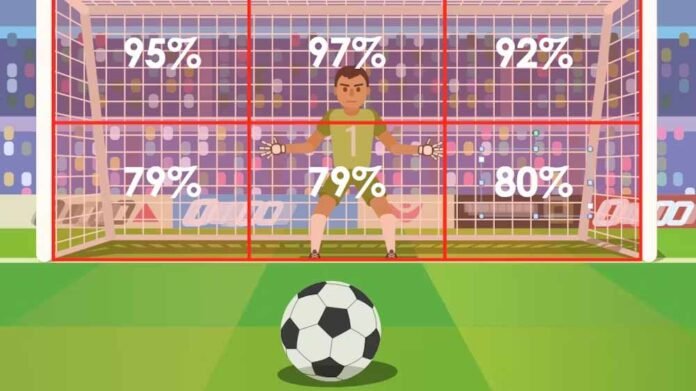Professional footballers sometimes use a mathematical strategy to help them score a penalty, or save one – and it all comes down to randomness.
As we reach the latter stages of any major football tournament, penalty shootouts between evenly matched teams seem almost to be an inevitability. An absorbing spectacle for neutral watchers, agonising for the fans of the teams involved, and potentially career-defining for the players – the penalty shootout offers a form of sporting drama almost unrivalled in its acute tension.
And so it transpired on Thursday night, when England and Sweden couldn’t be separated over normal and then extra time in their Euro 2025 quarter final (read more analysis of the game on BBC Sport). Up stepped Allessia Russo for England to take the first kick putting it just beyond the reach of the diving Swedish keeper Jennifer Falk. But England would not score again for the next three kicks. Falk dived the right way and saved all three. When the camera cut to Falk before England’s fifth penalty she could be seen consulting her water bottle on which the names of the England penalty takers and their preferred penalty direction were listed.
Fortunately for England, Sweden were equally wayward with their penalties – goalkeeper Hannah Hampton saving two while two others missed the goal completely – leaving the sides tied on two scored and four missed after six penalties each. Up stepped stalwart defender Lucy Bronze to take what would transpire to be England’s last penalty; blasting it right down the middle over the legs of a diving Falk. Teenager Smilla Holmberg then skied Sweden’s final spot kick to spark scenes of jubilation amongst the England players.
In her interview after the game, Bronze (whose mum is a maths teacher, and who achieved a very apt bronze award in the UK Mathematics Trust challenge while at school) discussed why she chose to blast her penalty straight down the middle.
Bronze’s comments raise an important question: can mathematics help players determine how they should take their penalties? What can they do to make it more likely that they hit the back of the net? Should they go high or low, left or right or perhaps down the middle? Should they put their boot through it as hard as they can or should they aim for placement above all else? Does it pay off to opt for a “Panenka” – a chipped penalty kick down the centre of the goal relying on the keeper diving one way or the other? Audaciously brilliant if it works, but embarrassing if the keeper doesn’t buy the dummy and the ball floats gently into their open hands.
(BBC)
Friday, October 31, 2025

